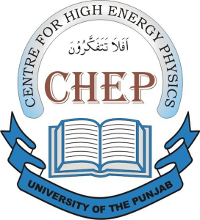Centre for High Energy Physics
 Official logo | |
| Motto | Hard work is key to success |
|---|---|
| Type | Education and Research |
| Established | 1982 |
| Director | Prof. Dr. Haris Rasid |
| Students | 300~400 regular |
| Location | , , |
| Campus | Quaid-i-Azam Campus (New Campus) |
| Colors | Cardinal Red and Steel Gray[a] |
| Affiliations | HEC |
| Mascot | CHEPIAN |
| Website | chep-pu.edu.pk |
The Centre for High Energy Physics at the University of the Punjab is a center for high energy physics, a branch of fundamental Physics. It is concerned with unraveling the ultimate constitutes of matter and with elucidating the forces between them. The experimental research in high energy physics is exceeding complicated and expensive and involves billions of dollars.
History of Centre for High Energy Physics
Research in theoretical high energy physics started at the University of the Punjab in 1968 in a limited facility. But understanding the need of time and the value of high energy physics, the university management agreed to establish a whole new department in which the research and teaching on high energy physics will be done. In November 1982 Centre for high energy physics was established and entrusted with the objective of carrying out teaching and research in this field leading M. Phil. to PhD.
Logo
The centre has a logo which shows a book as a sign of knowledge, and an Arabic verse from the Qur'an which translates to "why don't you think?" . It means look at your surroundings and think. On the top is the department's name and at the bottom is the name of the university.
Building
CHEP has good locations in the university. It stands in the new campus of the University of the Punjab near the main gates of the university (Gate no. 1 and Gate no. 2). CHEP has a three-storey building with its own library (other than the university main library), five computer labs: a programing, modeling and simulation lab, a supercomputer lab, a physics lab, a modern physics lab and an electronics lab.
The building stands in front of the Institute of Chemistry & the Under-graduate Block, next to the Institute of Biochemistry. Behind the center lies the university jogging ground.
Research Areas
- Harmonic Physics
- Experimental High Energy Physics (data analysis)
- Parallel processing and high performance Computation
- Medical Physics (modeling and Simulation)
- Computational analysis of physical properties of solids
- Phenomenology of weak decay and CP Violation
- Neutrino Physics
- Meson-Meson Physics
- Physics Education
- Quantum Physics
- Electromagnetism
- Scientific Computation
- Solid State Physics
- Thermal Physics
Academic Programs
BSc. (Hons.) In Computational Physics (4 Years)
MSc. (Hons.) In Computational Physics (2Years)
M.Phil. in High Energy Physics (2 Years)
Ph.D. in High Energy Physics (3 to 5 Years)
